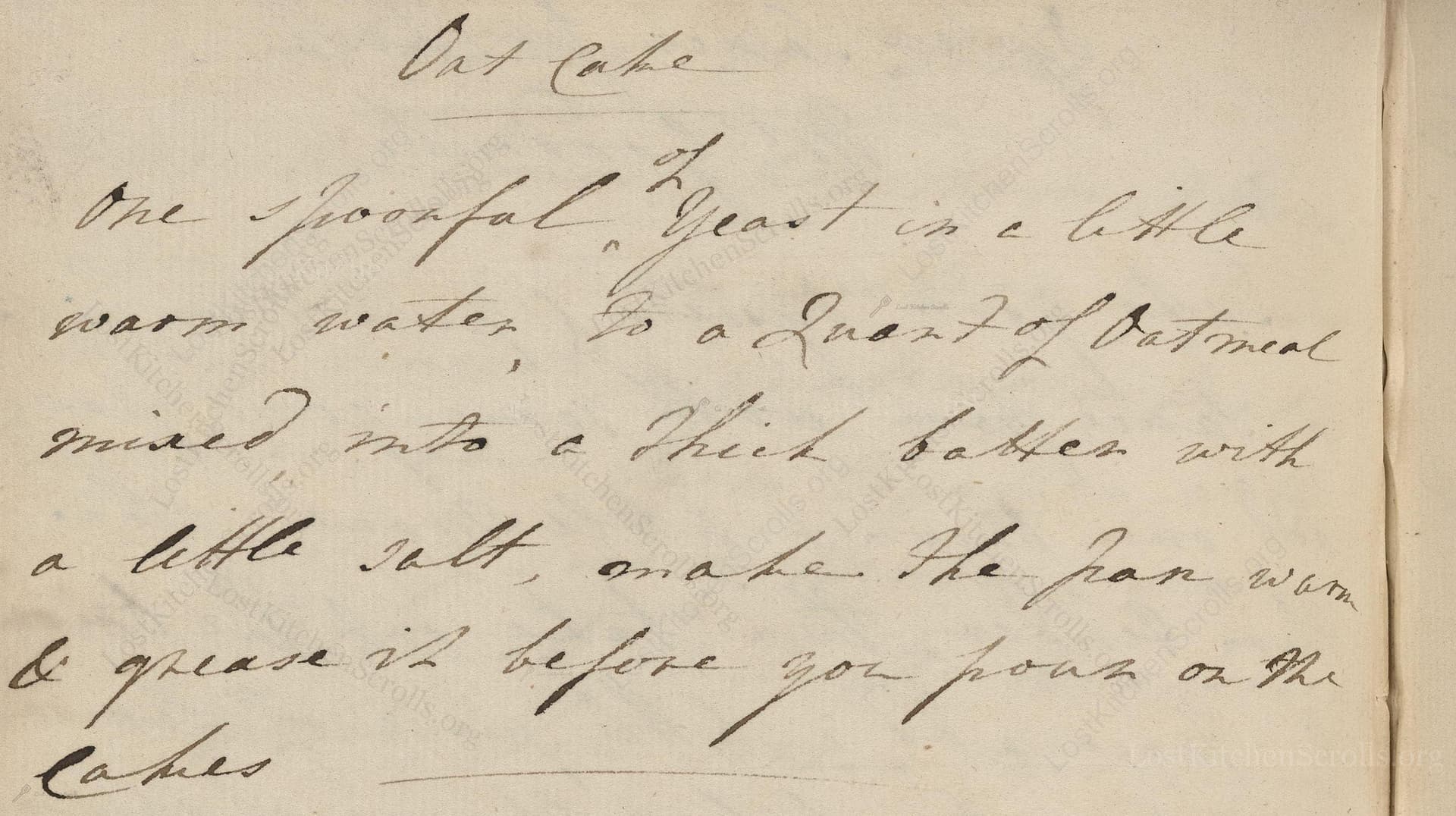Oat Cake
From the treasured pages of Cookbook of Elizabeth Langley
Written by Elizabeth Langley

Oat Cake
"One Spoonful of Yeast in a little warm water. To a Quart of Oatmeal mixed into a Thick batter with a little Salt, make the pan warm & grease it before you pour on the Cakes."
Note on the Original Text
The original recipe is written in a brisk, matter-of-fact style, assuming a fair bit of kitchen experience from its reader. Measurements are imprecise—using terms like 'one spoonful' and 'a little warm water'—because most cooks of the time cooked by feel and eye. 'Quart' refers to a British quart (about 1.14 liters), though here adapted for modern portioning. Spelling and capitalization varied; 'yeast' might refer to ale barm or baker's yeast. Cakes in this context are flatbreads, not the sweet confections we often expect today.

Title
Cookbook of Elizabeth Langley (1757)
You can also click the book image above to peruse the original tome
Writer
Elizabeth Langley
Era
1757
Publisher
Unknown
Background
Step into the Georgian kitchen with Elizabeth Langley's 1757 culinary collection, where refined techniques and delightful recipes await those with a taste for historic gastronomy.
Kindly made available by
Folger Shakespeare Library
This oat cake recipe comes from Elizabeth Langley's 1757 collection, at a time when oats were a staple grain in many British households, especially in Scotland and Northern England. Oat cakes were an affordable, nourishing, and versatile food for all classes, providing vital sustenance long before the modern bakery loaf dominated breakfast tables. The recipe’s brevity reflects common knowledge of bread-making among 18th-century home cooks, and its simplicity speaks volumes about daily life—thrifty, practical, and reliant on a few enduring ingredients.

In the 18th century, the oat cake would have been made using a simple earthenware or wooden bowl for mixing, a wooden spoon or hand for stirring, and a cast-iron griddle or flat pan set over the open hearth fire. Greasing was typically done with lard or rendered animal fat, and the warmth of the pan was judged by hand or experience, rather than by thermometer.
Prep Time
10 mins
Cook Time
8 mins
Servings
6
We've done our best to adapt this historical recipe for modern kitchens, but some details may still need refinement. We warmly welcome feedback from fellow cooks and culinary historians — your insights support the entire community!
Ingredients
- 1/4 ounce active dry yeast (or historical ale/baker's yeast)
- 1/4 cup warm water
- 1 3/4 cups oatmeal (rolled oats or steel-cut/pinhead oats)
- 1/2 teaspoon salt
- 1 1/2 cups warm water (approximate, to make a thick batter)
- Butter or oil, for greasing pan
Instructions
- To make this oat cake in a modern kitchen, begin by dissolving 1/4 ounce (about 1 teaspoon) of active dry yeast in 1/4 cup of warm water.
- In a large bowl, mix 1 3/4 cups of rolled oats (or, for a more authentic touch, use steel-cut or pinhead oatmeal) with a generous pinch of salt.
- Pour in just enough warm water—about 1 1/2 cups—to create a thick batter.
- Stir in the yeast mixture and combine well.
- Lightly grease and warm a heavy skillet or griddle over medium heat.
- Drop ladlefuls of batter onto the skillet to form small cakes, and cook until golden brown on both sides, about 4 minutes per side.
- Serve warm for a simple, hearty treat.
Estimated Calories
190 per serving
Cooking Estimates
You will need about 10 minutes to mix and prepare the batter, and 8 minutes to cook each batch of oat cakes. Each serving contains about 190 calories. This recipe makes 6 oat cakes.
As noted above, we have made our best effort to translate and adapt this historical recipe for modern kitchens, taking into account ingredients nowadays, cooking techniques, measurements, and so on. However, historical recipes often contain assumptions that require interpretation.
We'd love for anyone to help improve these adaptations. Community contributions are highly welcome. If you have suggestions, corrections, or cooking tips based on your experience with this recipe, please share them below.
Join the Discussion
Rate This Recipe
Dietary Preference
Main Ingredients
Culinary Technique
Occasions

Den Bockfisch In Einer Fleisch Suppen Zu Kochen
This recipe hails from a German manuscript cookbook compiled in 1696, a time whe...

Die Grieß Nudlen Zumachen
This recipe comes from a rather mysterious manuscript cookbook, penned anonymous...

Ein Boudain
This recipe comes from an anonymous German-language manuscript cookbook from 169...

Ein Gesaltzen Citroni
This recipe, dating from 1696, comes from an extensive anonymous German cookbook...
Browse our complete collection of time-honored recipes



